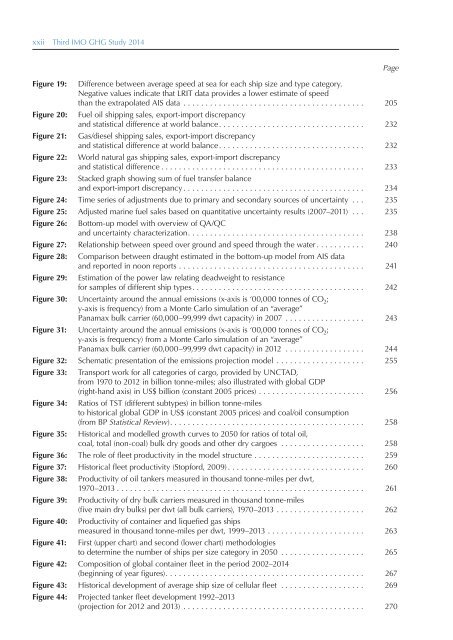MnrAq
MnrAq
MnrAq
You also want an ePaper? Increase the reach of your titles
YUMPU automatically turns print PDFs into web optimized ePapers that Google loves.
xxii Third IMO GHG Study 2014<br />
Page<br />
Figure 19: Difference between average speed at sea for each ship size and type category.<br />
Negative values indicate that LRIT data provides a lower estimate of speed<br />
than the extrapolated AIS data ......................................... 205<br />
Figure 20: Fuel oil shipping sales, export-import discrepancy<br />
and statistical difference at world balance ................................. 232<br />
Figure 21: Gas/diesel shipping sales, export-import discrepancy<br />
and statistical difference at world balance ................................. 232<br />
Figure 22: World natural gas shipping sales, export-import discrepancy<br />
and statistical difference .............................................. 233<br />
Figure 23: Stacked graph showing sum of fuel transfer balance<br />
and export-import discrepancy ......................................... 234<br />
Figure 24: Time series of adjustments due to primary and secondary sources of uncertainty ... 235<br />
Figure 25: Adjusted marine fuel sales based on quantitative uncertainty results (2007–2011) ... 235<br />
Figure 26: Bottom-up model with overview of QA/QC<br />
and uncertainty characterization ........................................ 238<br />
Figure 27: Relationship between speed over ground and speed through the water ........... 240<br />
Figure 28: Comparison between draught estimated in the bottom-up model from AIS data<br />
and reported in noon reports .......................................... 241<br />
Figure 29: Estimation of the power law relating deadweight to resistance<br />
for samples of different ship types ....................................... 242<br />
Figure 30: Uncertainty around the annual emissions (x-axis is ‘00,000 tonnes of CO 2 ;<br />
y-axis is frequency) from a Monte Carlo simulation of an “average”<br />
Panamax bulk carrier (60,000–99,999 dwt capacity) in 2007 .................. 243<br />
Figure 31: Uncertainty around the annual emissions (x-axis is ‘00,000 tonnes of CO 2 ;<br />
y-axis is frequency) from a Monte Carlo simulation of an “average”<br />
Panamax bulk carrier (60,000–99,999 dwt capacity) in 2012 .................. 244<br />
Figure 32: Schematic presentation of the emissions projection model .................... 255<br />
Figure 33: Transport work for all categories of cargo, provided by UNCTAD,<br />
from 1970 to 2012 in billion tonne-miles; also illustrated with global GDP<br />
(right-hand axis) in US$ billion (constant 2005 prices) ........................ 256<br />
Figure 34: Ratios of TST (different subtypes) in billion tonne-miles<br />
to historical global GDP in US$ (constant 2005 prices) and coal/oil consumption<br />
(from BP Statistical Review) ............................................ 258<br />
Figure 35: Historical and modelled growth curves to 2050 for ratios of total oil,<br />
coal, total (non-coal) bulk dry goods and other dry cargoes ................... 258<br />
Figure 36: The role of fleet productivity in the model structure ......................... 259<br />
Figure 37: Historical fleet productivity (Stopford, 2009) ............................... 260<br />
Figure 38: Productivity of oil tankers measured in thousand tonne-miles per dwt,<br />
1970–2013 ........................................................ 261<br />
Figure 39: Productivity of dry bulk carriers measured in thousand tonne-miles<br />
(five main dry bulks) per dwt (all bulk carriers), 1970–2013 .................... 262<br />
Figure 40: Productivity of container and liquefied gas ships<br />
measured in thousand tonne-miles per dwt, 1999–2013 ...................... 263<br />
Figure 41: First (upper chart) and second (lower chart) methodologies<br />
to determine the number of ships per size category in 2050 ................... 265<br />
Figure 42: Composition of global container fleet in the period 2002–2014<br />
(beginning of year figures) ............................................. 267<br />
Figure 43: Historical development of average ship size of cellular fleet ................... 269<br />
Figure 44: Projected tanker fleet development 1992–2013<br />
(projection for 2012 and 2013) ......................................... 270


